What Is a Hard Start Kit? Does Your Air Conditioner Need a Hard Start Kit?
Did you know it takes
4 to 8 times more electrical current to start your central AC unit than is required to run it? The excess heat generated during startup is damaging to your central air conditioning system compressor. A hard start kit can benefit you if:
- You want to extend the life of the HVAC system
- Your air conditioning system is aging
- You have a home generator
- Low voltage or inconsistent voltage
- Lights dim when AC unit starts
- Compressor won't start/Humming
- AC system has a TXV metering device
- Multiple AC systems running at once
- Air conditioner trips breaker on startup
- Long refrigerant line sets ( multi-story buildings etc.)
What is a Compressor Hard Start Kit?
A hard start kit is a start capacitor and a potential relay or PTC ( positive temperature coefficient ) device. They are designed to give your air conditioning compressor an electrical boost upon startup.
What Does a Hard Start Kit Do?
A hard start kit helps your AC compressor start up to 10 times faster and more efficiently. It helps overcome the mechanical inertia upon startup. The first couple of seconds for any electrical motor/compressor is when the most strain electrically is placed upon it. Amperage spikes momentarily on startup then drops to normal operating levels. It is this amperage spike that tends to create problems. The excess amperage equals excess heat that can be damaging to your electrical system in your air conditioning system.
How Does an HVAC Hard Start Kit Work?
A hard start kit provides greater starting torque and reduces the duration of inrush current to the single phase compressor. The start capacitor of the hard start kit is wired in parallel with a normally closed potential relay or PTC thermistor with the
compressor run capacitor. Once the circuit is energized, the start capacitor alters the phase angle ( think of it as electrical leverage) between the start and the run winding. Once the compressor is running, the start capacitor drops out of the circuit leaving only the run capacitor to keep the compressor running. The start capacitor is only in the circuit for a fraction of a second.
** Before any hard start kit is installed, the compressor run capacitor must be checked to confirm it is still within its designed, rated specifications.
Types of Air Conditioning Hard Start Kits:
- PTC Hard start kit - This style of hard start uses a ceramic element to take the start capacitor out of the circuit. As electric current flows through the PTC element, it begins to heat up to approximately 250 degrees. The electrical resistance in the device increases and opens the circuit, and the start capacitor is taken out.All this happens in less than a second. There are a couple of potential problems with this style of hard start kit. Every time the PTC hard start is energized, it must cool down ( 2 to 3 minutes ) before it can energize the start capacitor again. Also, this style device is "dumb" meaning it provides a fixed boost - not sensing if the compressor actually started and may stay in the circuit a little longer than necessary or drop out prematurely.
- Mechanical Potential relay hard start kit - ( Recommended ) This style hard start kit uses a potential relay to take out the start capacitor of the circuit upon startup. Once the AC compressor is at approximately 75% to 80% its full operating speed, back EMF (electro-motive force) generated by the compressors rotor creates a magnetic field that opens the relay, taking the start capacitor out of the circuit.Once the compressor stops- the relay closes again and is ready for the next cycle. Potential relay hard starts are more precise than PTC hard starts because it drops the start capacitor out of the circuit predictably every time and doesn't need to cool down to reset.
If a Hard Start Kit is so Important, Why Aren't They Installed at the Factory?
Years ago, every single phase
residential air conditioning unit did have hard start kits from the factory. But in efforts to reduce the cost of manufacturing, they have been eliminated in most units.
Considering getting a hard start kit? Not sure if your system already has one? Contact the HVAC professionals from Air Zero. 727-392-6111 Air Zero is located in Largo FL. and provides air conditioning services to all of Pinellas County Florida. Other recent blog posts of interest : Home AC Thermostat Not Working? Thermostat Questions? Why Is My House So Dusty? Where Does Dust Come From? AC Not Turning On | Central Air Conditioner Not Cooling | DIY Tips
__________________________________________
Electric Motor Starting Capacitor Selection
Selection Guide to A/C Compressor & Other Electric Motor Start-Boost Capacitors
Â
Electric motor start-run capacitor selection guide:
This article explains how to choose & buy an electric motor start capacitor, hard start capacitor, or run capacitor that is properly rated for and matches the requirements of the electric motor such as an AC compressor motor or fan motor where the capacitor is to be installed.
This electric motor capacitor article series explains the selection, installation, testing, & use of electric motor starter start and run capacitors used on various electric motors found in or at buildings such as air conditioner compressors, fan motors, some well pumps and some heating equipment.
These electric motors use a capacitor to start and run the motor efficiently. We explain the choice & wiring procedures for a hard start capacitor designed to get a hard-starting air conditioner compressor motor, fan motor, refrigerator, or freezer compressor or other electric motor (such as a well pump) going.
We also provide a MASTER INDEX to this topic, or you can try the page top or bottom SEARCH BOX as a quick way to find information you need.
Green links show where you are. © Copyright 2017 InspectApedia.com, All Rights Reserved.
How to Find, Choose, & Buy a Replacement Electric Motor Starting Capacitor
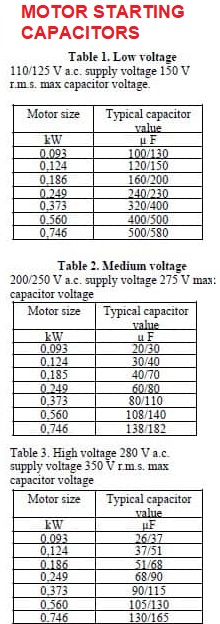
Watch out: do not attempt electrical repairs if you are not trained and equipped to do so. Making a mistake can cause a fire or serious injury or death.
Definition of capacitance or capacitor
Capacitance is the ability of a device to store an electrical charge.
An electric motor capacitor is a device that first stores, then releases an electrical charge to help start an electrical motor (starting capacitor) or to keep it spinning (run capacitor) - the electrical charge or potential energy stored in the capacitor is used to give a power boost to the motor to help it overcome inertia - to start rotating.
How do you know that an electric motor needs a replacement starting capacitor?
If the electric motor hums without starting or has trouble starting, but will run if given a push (e.g. a spin of a fan blade - watch out for chopped-off fingers) the start cap is probably bad.
If the starting capacitor is bulged, burned, has a hole in it, or has leaked oil, it is shot and needs replacement.
[Click to enlarge any image]
How do you know that an electric motor needs a replacement run capacitor
If the electric motor draws high current when running or hums and won't start the run cap is probably bad. If the motor hums but the thermal overload protection switch has not tripped, the start cap is probably bad.
If the run capacitor is bulged, burned, has a hole in it, or has leaked oil, it is shot and needs replacement.
Some motors use a combined start/run capacitor
A start/run capacitor combines the start capacitor and run capacitor functions in a single device. These caps will have three electrical terminals:
S = start wire connector
R = Run wire connector
C = common connector
Â
Some equipment uses a dual capacitor
A dual capacitor - combines two capacitors in a single physical device, one to run a higher-amperage motor such as the compressor in an air conditioner compressor/condenser unit, and a second smaller capacitor to run a smaller motor such as the cooling fan motor in the compressor/condenser unit.
Where is the capacitor? If you can't find the capacitor,
see LOCATE the STARTING CAPACITOR,
Some motors don't use capacitors or use only a run capacitor
Watch out: not all electric motors, such as pool pumps, use starting or run capacitors.
For example a split-phase motor, often used in spas and hot tubs and at many above-ground swimming pools, uses a start switch and start winding but does not use a starting nor a run capacitor.
A "permanent split capacitor" motor uses a run capacitor but not a starting capacitor. Motors of this design, often found in in-ground swimming pool pumps, have a low starting torque and need only a run cap.
How to Choose a Replacement Motor Capacitor - 4 Methods
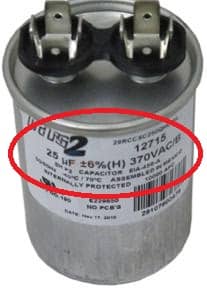 The best option if you are replacing a starting capacitor or a start/run capacitor is to match the existing device on your system.
The best option if you are replacing a starting capacitor or a start/run capacitor is to match the existing device on your system.
That means noting the data printed on the existing capacitor - if it's legible and matching that.
Our capacitor tables given at the start of this article also provide general advice on matching a motor capacitor to the motor voltage and size ratings in Volts and kW or kilowatts.
[Click to enlarge any image]
Our photo illustrates a Mars-brand starting capacitor rated at 25uF and 370VAC - this cap is used ion AO Smith motors and is identified as 25MFD 370V - 628318-307.
Since there are just two terminals we know this isn't a start+run capacitor.
How to Match a Replacement Capacitor for an Electric Motor
Options for matching a replacement motor capacitor include the following
- Examine the original capacitor and match its ratings in Voltage and and capacitance, uF or micro farads.
Look for and record all of the markings on the capacitor.
Typically you'll see a rating in microfarads like the 25uF in our capacitor photo above, and you'll also see a voltage range rating such as the 370VAC (maximum voltage) rating also in the red circle of our photo above.
- Take the capacitor or the whole electric motor to a motor rebuild-shop or to your local electrical supplier
If the capacitor markings are legible, they'll be able to match it.
If the capacitor markings are not legible the electrical supplier or motor re builder will recommend a start, run, or combination capacitor based on the motor data tag information.
What if the Capacitor is Lost or Has No Legible Markings?
With the motor brand and model (and hopefully serial number in hand) you can also get the exact OEM part number - contact the motor manufacturer they can give you the exact OEM capacitor replacement part number or specifications.
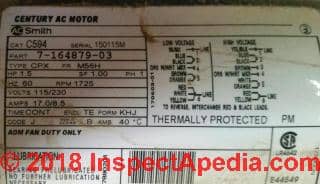
- Check the motor type & motor part number and data tag specifications and use a motor part substitution or OEM part catalog.
See capacitor and motor repair part catalogs given
at ELECTRIC MOTOR CAPACITOR CATALOGS
For readers whose capacitor has no markings whatsoever, your electrical supplier will want to know the technical details about the capacitor's intended use. Those can be found on the motor data tags for the motor served by the cap.
Typical pool/spa motor capacitors: some pool pumps use a motor that gets a start-up boost from a starting capacitor.
For example a typical aboveground pool, hot tub or spa motor will use a starting capacitor rated around 50-400 MFD and 125 or 250 VAC. And for the same motor, the run capacitor will be rated around 15-50 MFD and 370 VAC.Â
Capacitor Voltage Rating Selection Limits
The voltage rating of a capacitor indicates the highest nominal voltage at which it is designed to operate.
Use of a capacitor at voltages below its rating will do no harm.
Run capacitors must not be subject to voltages exceeding 10 percent of the nominal rating, and start capacitors must not be subjected to voltages exceeding 30 percent of the nominal rating.
The voltage to which a capacitor is subjected is not line voltage, but is a much higher potential (often called back electromotive force or back EMF) which is generated in the start winding. - COPELAND ELECTRICAL HANDBOOK [PDF] from Emerson [PDF]
Watch out: The voltage to which a capacitor is subjected is not line voltage, but is a much higher potential (often called back electromotive force or back EMF) which is generated in the start winding. On a typical 230 volt motor, the generated voltage may be as high as 400 volts and is deter-mined by the start winding characteristics, the compressor speed, and the applied voltage. - COPELAND ELECTRICAL HANDBOOK [PDF] p. A-9
- Choose a capacitor based on Electric Motor Type, Motor Horsepower or Motor Kw or Kilowatt rating
If you cannot find any data giving the motor's brand, model, specifications, and you have no markings nor even the actual old start/run capacitor from an electric motor, you might get into the right ballpark by choosing a capacitor based on the motor's horsepower and voltage and application.
If you don't even have that data, we're stuck. Take the motor to an electrical motor repair expert who might find markings you missed.
What if the Motor has No Data Tag? Ballpark Start-Run Capacitor Values
If the motor has no legible markings nor data tag, first check again. Some electric motors such as oil burner motors have data stamped right into the metal casing of the motor itself. The data may be there but only visible under good lighting.
But if your electric motor truly has no legible information about its specifications then you might consider these very basic capacitor ranges that can get a small electric motor running again:
Estimated Small Motor Capacitor "Ballpark" Sizes Based on Motor Type
|
| Motor Type 1 |
Start Capacitor uF / Voltage 1 |
Run Capacitor 1 |
| Air conditioner compressor |
30 µF 3 - 50 µF / 370 VAC [citation & data needed] |
5 µF 3- 7.5 µF |
| Oil burner motor 1/7 - 1/2 hp 5 |
20 µF / 370 VAC if used |
5 µF if used |
| Pool Pump |
50-400 µF / 120 / 250 VAC |
15-50 µF / 370 VAC (we think this is high - Ed.) |
| Table saw motor 1 - 1.5 HP |
160-200 µF / 120 / 250 VAC to 300 µF / 110-125 VAC |
30 µF / 370 VAC |
| Well pump motor 1/2-3/4 |
60-70 µF / 220VAC |
|
| Well pump motor 2 to 3 HP |
105-126 µF / 220VAC 4 to 160-200 µF / 220VAC |
|
...
Estimated Small Motor Capacitor "Ballpark" Sizes Based on Motor Horsepower
|
| Motor Horsepower 2 |
Start Capacitor µF / Voltage |
Run Capacitor |
| 1/8 Hp or 0.1 KW, 120-150 VAC 2 |
100-130 µF |
4 to 5 µF 370VAC |
| 1/2 Hp or 0.37 KW, 120-150 VAC |
320-400 µF |
10 µF 370VAC |
| 1 Hp or 0.75 KW, 120-150 VAC |
500-580 µF |
10-15 µF 370VAC |
| 2 Hp or 1.5 KW, 200-250VAC |
500-580 µF |
10-15 µF 370VAC |
| 3 Hp or 2.25 KW, 200-250VAC |
[citation & data needed] |
20-25 µF 370VAC |
| 5 Hp or 3.75 KW, 200-250VAC |
[citation & data needed] |
30 µF - 40 µF 370VAC |
Â
Notes to the tables above
Watch out: as a general rule of thumb, electric motor start capacitors can be replaced with a micro-farad or µF or mfd rating equal to or up to 20% higher µF than the original capacitor serving the motor. On the replacement capacitor the voltage rating must be equal to or greater than the original.
Watch out: do not touch an electric motor capacitor nor any other electrical components before you have removed electrical power and SAFELY discharged the capacitor or you can get a serious shock or injury.
Replacement capacitor for-sale listings may be described leaving you to interpret the numbers, such as this example: 35+5 uF +5%, 370VAC, 50/60Hz - this is a 35µF Start + 5µF Run capacitor, capable of handling voltage up to 370 volts alternating current (so you're ok with 120 volts or 240 volts).
1. Watch out: these are only "ballpark guesstimates" - check with the manufacturer of your specific motor and application.
For example among the motor type "pool pump" horsepower range may mean different capacitor values.
If your capacitors burn out quickly there are several common reasons: wrong capacitor size (too small), motor is damaged, or mis-wiring.
2. The KW and VAC data are excerpted from the small motor capacitor table based on motor voltage and horsepower in
ELECTRIC MOTOR CAPACITOR RATING TABLES given at the start of this page
3. Typical replacement sold for a Goodman brand air conditioner at online parts suppliers - Ed.
4. Typical replacement sold at WallMart June 2018
Watch out: Wallmart capacitor prices on 20187/06/30 were observed to be up to ten times or more higher than other vendors of the same or equivalent parts. Check also with your local electrical supplier.
5. Watch out also: not all motors use start, run, or combination capacitors, and some motors such as those sporting a switchless motor or "PSC" (Permanent Split-Capacitor) motor requires a run capacitor that improves motor efficiency and stays in-circuit when the motor is starting or running.
Capacitor Ratings in Farads or micro-Farads µF and Voltage VAC
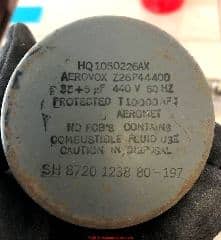 Capacitor energy ratings are expressed in farads - the amount of electrical power stored in the capacitor, where µF or µF = microfarad (10-6 farads) and is the same as mfd (microfarads) written in other references.
Capacitor energy ratings are expressed in farads - the amount of electrical power stored in the capacitor, where µF or µF = microfarad (10-6 farads) and is the same as mfd (microfarads) written in other references.
Rated capacitance for a capacitor is the capacitance value (electrical energy storage value) for which the capacitor is designed.
The rated capacitance has to be sufficient to give the energy boost or kick to the electric motor to start it spinning (a start capacitor) or to help keep it spinning (run capacitor).
Capacitors are also rated for the voltage range in which the capacitor can safely operate, such as 220V or 440V.
The starting capacitor photo shown here, provided 2018-07-10 by reader Robert, is marked as rated 35 +5 uF 440V 60HZ.
That's 35 microfarads +5% and is the capacitor rating, along with voltage, that the reader will need to specify when buying a replacement.
We also see a specific part number: SH 8720 1238 80-197, but I in replacing this capacitor you'd attend first the rated capacitance and voltage.
[Click to enlarge any image]
Rated voltage for a capacitor is defined as the highest continuous voltage that can be applied to the capacitor at its rated temperature without damage.
Depending on the application, the micro-farad range of starting capacitors varies according to the motor size.
Start capacitors typically range from 20-30 µF up to 250-300 µF. The example capacitor charts at the start of this article are adapted from AFCAP. [2]
The voltage range for a start-up capacitor typically ranges from 250VAC to 450VAC.
Watch out: When you are replacing an electric motor capacitor, never put in a lower rated capacitor. If you cannot get an exact size match to the original motor capacitor, it is acceptable to use a capacitor rated one step higher in µF. The substitute capacitor must be able to handle the voltage.
Run capacitors typically range in micro-farads from 1.5 to 50µF. or 50 microfarads or MFDs.
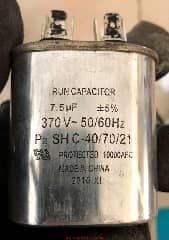 For example you can't sub a 110V-rated capacitor into a 220V system.
For example you can't sub a 110V-rated capacitor into a 220V system.
Robert's run capacitor shown here is rated at 7.5 µF +/- 5%, 370 Volts, and 50/60~ or cycles. The cap also sports it's part number.
You can also check a capacitor to compare its performance with its microfarad rating by using an ohmmeter. In a working capacitor ohms will build-up and then fall off (when the capacitor discharges).
Details of that procedure are
at TEST a MOTOR START or RUN CAPACITOR
HVAC suppliers sell general-use starting capacitors that are intended for use across a range of electrical motors and motor sizes.
But at least some industry sources (the Sealed Unit Parts Company or Supco) make a more careful argument explaining that it's best not to install a significantly oversized starting capacitor on an electric motor.
According to Supco, [quoting]
If the start capacitor is too large for the application, the capacitor can actually mask the developed voltage in the start windings and keep the start capacitor in the circuit continuously. .... The ... run-start voltage is suppressed below the trigger voltage of the start device. As a result, the start capacitor remains in the circuit as the motor runs.
A secondary, fail-safe method is necessary to ensure that the start device is ultimately removed from the circuit.
... A start device that fails to remove the start capacitor from the circuit has the potential to cause premature failure of the start windings in the compressor. ... If the capacitor is never removed from the start windings, premature winding failure could occur. As such, care should be taken when selecting capacitor sizes for an application.
Care should also be taken regarding products that tout a "bigger capacitor is better" approach to compressor starting. SUPCO E-Class devices provide a secondary timing safety device to ensure that the start capacitor is dropped from the circuit in a fail-safe mode. [Italics are ours-Ed.].
Electric Motor Capacitor Working Class
Capacitors are also rated in working classes which describe the expected service life of the capacitor in hours, assuming the cap has been properly selected.
Electric Motor Capacitor Working Class
|
| Working Class |
Rated life in hours of use |
| Class A |
30,000 |
| Class B |
10,000 |
| Class C |
3,000 |
| Class C |
1,000 |
Notes to the table above
Sources:
Kemet, Capacitors for AC Motor Applications, [PDF] Kemet Electronic Components, 941 Linda Vista Dr, West Chester, PA 19380 USA, Website: http://www.kemet.com/ retrieved 2018/06/18, original source: http://www.kemet.com/Lists/ProductCatalog/Attachments/158/F9000_GenInfo_MotorCaps.pdf
WEG, Specifications of Electric Motors [PDF], retrieved 2018/06/18, original source: http://ecatalog.weg.net/files/wegnet/WEG-specification-of-electric-motors-50039409-manual-english.pdf
Â
Examples & Sources of Start / Run Motor Capacitors
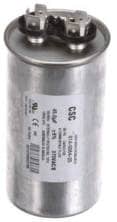
- Copeland Industrial Capacitors such as the Copeland Stoelting 231047 run capacitor shown here for use in a Copeland brand HVACR compressor motor system.
- Packard 370V 45+5 MFD Round Run Capacitor
- Supco™ 30+5 MFD 440V 440 Volt 50/60 Hz Round Motor Capacitor (typical application for Amana, Carrier, Rheem, Trane equipment)
- Supco™ 45+5 MFD 440V 440 Vol 50/60 Hz Round Motor Capacitor (typical application for Amana, Carrier, Rheem, Trane equipment)
- Supco HS6 (SPP6) Hard Start Relay Capacitor (230V) gives a starting torque boost of up to 500%. Quoting from product sales literature:
The SUPCO SPP6 Super Boost hard start capacitor increases starting torque up to 500%. Features: Installs in seconds across run capacitor terminals Contains specially designed relay and large start capacitor for severe hard start problems.
Applications: Room A/C units, Residential and commercial PSC A/C units and heat pumps, For all PSC A/C units from 4,000 thru 120,000 BTU's (1/2 thru 10 H.P.) Can be used on 120 thru 288 VAC units, For severe low voltage and hard starting compressors.
SPP6 Specifications: Voltage: 115V - 230V. Increased Torque: 390 ounce inches. - retrieved 6/16/14 Amazon.com sales
- Supco™ Universal (broad application) Capacitor, 10 MFD at 370V
Start & Run & Dual Capacitor Guidebooks, Catalogs, Cross-References, Sources, Specifications
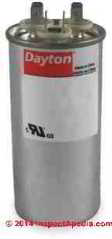
- AO Smith Electric Motors, CENTURY POOL & SPA MOTOR MANUAL [PDF] AO Smith Electrical Products Co., 531 North Fourth Street, Tipp City, OH 45371 USA Website: www.aosmithmotors.com (937) 667-2431 - includes troubleshooting, repair, replacement, capacitor testing
- AO Smith ELECTRIC MOTORS for the FARM [PDF] Op. Cit.
- Century Electric Motors (Previously A.O. Smith Electric Motors), CENTURY POOL & SPA MOTORS REPLACEMENT PARTS & MOTOR CROSS REFERENCE MANUAL (2012) Distribution Marketing 1325 Heil Quaker Blvd. LaVergne, TN 37086 PH: 866-887-5216 FAX: 800-468-2062 centuryelectricmotor.com
- Century Electric Motors (Previously A.O. Smith Electric Motors), SINGLE & THREE PHASE INTEGRAL HORSEPOWER MOTORS [PDF] (2013)
- Century Electric Motors (Previously A.O. Smith Electric Motors), V-GREEN 165 VARIABLE SPEED ELECTRIC MOTOR MANUAL [PDF]
- Conis Elco Ltd., CAPACITORS for MOTOR APPLICATIONS, [PDF], Website: http://www.conis-bg.com/EN/, retrieved 2018/06/18, original source: http://www.elcomp.net/conis.pdf
- COPELAND ELECTRICAL HANDBOOK [PDF], Emerson Climate Technologies, White-Rodgers US 8100 West Florissant Avenue Saint Louis MO 63136 USA, Customer Support: email: wr.techsupport@emerson.com, Tel: 1-888-725-9797 U.S. & Canada
- Essex, Brown: "Motor Repair Supplies" (Catalog), Essex Group, Inc., 1601 Wall St., Fort Wayne, Indiana 46801, Tel: 219-461-4633, Website: www.superioressex.com, retrieved 6/20/14, original source: http://www.essexbrownell.com/uploadedFiles/Content/Products/MR%20Supplies%20Catalog-s.pdf - see pp. 86-89.
- MOTOR START and RUN CAPACITORS [PDF] AFCAP (African Capacitors Limited), Metallized polypropylene film capacitors for motor running applications web search 08/05/2011, original source: http: //www.afcap.co.za /manual/Part2.pdf; 2018/07/11 update: the original source link is no longer valid - Ed.
- Sealed Unit Parts Co., Inc., PO Box 21, 2230 Landmark Place, Allenwood NJ 08720, USA, Tel: 732-223-6644, Website: www.supco.com, Email: info@supco.com, Website: http://www.supco.com/ , Supco Catalog, retrieved 6/20/14, original source: http://www.economicelectricmotors.com/cdrom/catalogs/Supco_catalog.pdf - see pp. 2-6.
Supco provided the compressor starting capacitor and packaging information (purchased by the author from an air conditioning parts supplier in New York) - our example uses a Sealed Unit Parts Company Solid State part No. RSC 10 115V starting capacitor which was designed for installation on refrigerators and freezers. See www.supco.com/
"The E Class Advantage", Supco (op cit), describes the company's advanced start/run capacitor products. Web search 08/04/2011, original source: http://www.supco.com/eclassadvantage.htm Quoting from that article:
The SUPCO E-Class Series comprise the most advanced developments in start device technology:
1. Voltage sensing technology that monitors for motor start (current sensing devices require internal fuse protection).
2. A 2-wire connection that simplifies installation
3. A secondary timing circuit that ensures that the capacitor is not permanently left in the start winding circuit
4. A fully electronic device - minimizing the limitations of mechanical devices and secondary fusing associated with triac devices
5. A start device matched with an appropriately sized capacitor to cover the range of compressors for the intended application (one size does not fit all)
The use of compressor start devices results from a need to ensure that a compressor (usually air conditioning) will start under voltage conditions that are less than ideal. As discussed, several options exist in the market to address compressor start concerns. Start devices exist in many forms for specific applications.
SUPCO provides a full range of products in all relevant technologies to effectively match the proper start device to the application.
Care should be taken to utilize a device that meets the requirements of the job.
Extra caution should be observed when employing the "one-size-fits-all" and "a bigger capacitor is better" approach to applying a start device. Consult SUPCO, a manufacturer with a complete product range, to ensure the greatest success in the start device application.
- van Roon, Tony, "Capacitors", [online article], retrieved 6/20/14, original source: http://www.sentex.ca/~mec1995/gadgets/caps/caps.html, gives a very detailed history of the invention and history of electrical capacitors beginning with van Musschenbroek's Leyden jar in 1745. This article includes "Capacitor Nomenclature" by Dean Huster.
- Kaiser, Cletus J., The Capacitor Handbook: A Comprehensive Guide For Correct Component Selection In All Circuit Applications. Know What To Use When And Where, 2d Ed., [at Amazon.com] C.J. Publishing (2011), ISBN-10: 0962852538, ISBN-13: 978-0962852534 - product description
This book provides practical guidance and application information when using capacitors in electronics and electrical circuit design. This easy-to-use book covers the following capacitor types: Ceramic, Plastic Film, Aluminum Electrolytic, Tantalum, Glass, Mica, and others.
This book also has a very comprehensive Glossary and Index. The Selection Guidelines and the Symbols and Equations sections have the answers to all of your daily application questions. This book is one in a series of component handbooks.
Where are the Motor Capacitors Found?
This now discussion has its own page - LOCATE the STARTING CAPACITOR
Reader Question: distributor says the order of numbers on the capacitor doesn't matter
6/16/2014 Danno said:
I'm replacing the capacitor in my AC condenser. The original/stock unit says 35/5 440 AC. This is the cap I ordered from a distributor, but upon receiving it, the box says "5/35 440" (the 5 and 35 are transposed. Distributor says its the same thing. Is this correct? Thanks for any 411
Reply:
Danno I think the scrambled order is not an issue as long as the key numbers on the capacitor match its application or match the old one AND as long as you connect the proper wires.
Example start/run capacitor markings
(NOT specifying your particular capacitor)
- Voltage, e.g. 110-125V
- Capacitance, e.g. 189-227 µF or micro Farads or MFD (Start capacitors usually are over 60 µF)
- Capacitance, e.g. for a dual run capacitor: 35/5 refers to 35 MFD (for a compressor) and 5 MFD (for a fan motor)
- Temperature range, e.g. -40 - + 65C
- Cycles, e.g. 50-60 Hz
Decode a 35/5/440 marking on a motor starting capacitor
Reader Mark (18 June 2014) has given us a helpful and detailed translation of the markings found on start capacitors, repeated here:
Run capacitors: I always was taught that 35/5 was a [dual] run capacitor. 35 is the microfarad rating for the compressor & 5 microfarad was for the fan. (three terminals) not:
Decode a 35/5/440 marking on a motor starting capacitor:
The capacitor you are describing marked 35/5 440 is probably a dual run capacitor.
35/5 : The first two numbers are the capacitance 35 µF (for the compressor) and 5 µF (for the fan motor).
A dual "run capacitor" supports two electric motors, such as in large air conditioner or heat pump units, with both a fan motor and a compressor motor.
It saves space by combining two physical capacitors into one case. The dual capacitor has 3 terminals labeled
"C",
"FAN", and
"HERM", which stand for the Common, Fan, and HERMetically sealed compressor.[5]
440 refers to the ability to run voltages up to 440VAC
Dual run capacitors come in a variety of sizes, depending on the capacitance (µF), such as 40 plus 5 µF, and also the voltage. (Be sure to connect properly to compressor motor, fan motor and common)
A 440 volt capacitor can be used in place of a 370 volt, but not a 370 in place of a 440 volt.[2]
The capacitance must stay the same within 5% of its original value.[2]
Round cylinder-shaped dual run capacitors are commonly used for air conditioning, to help in the starting of the compressor and the condenser fan motor.[2]
An oval dual run capacitor could be used instead of a round capacitor, but the mounting strap should be changed to better fit the oval shape
Watch out: Take a look at the wiring sheet that should be with your capacitor or wiring marked on the device itself to be sure that you are properly connecting the Start and Run wires and you'll be OK.
As we noted in the article above, the dual capacitor terminals may be labeled so that the three leads can be wired correctly:
- S = start wire connector
- R = Run wire connector
- C = common connector
Reader Question: your capacitor advice is all Greek to me
I have a Wayne 1 HP motor used as a utility pump. The capacitor burnt out. It is a rectangle plastic capacitor with two wires coming off of it.
The numbers on it are: 30 F /J/250VAC I don’t see a U before the F there are two symbols that look like arrows pointing to the right before the F letter. There is a name on it that says YUHCHANG ( P )
I read you article on how to choose a capacitor still it’s all Greek to me. So what am I looking for?
Thanks for your time, - Anonymous by private email 2016/06/19
Reply: How to Choose the Correct Capacitor: four options
Anon: in response to your query I've re-written our capacitor selection explanation.
Four ways to find a matching or replacement motor capacitor are given at CAPACITOR SELECTION TIPS in this article.
Also if you can, send me some sharp photos of the cap and its markings and I may be able to comment further. Post a photo of your existing motor capacitor and its markings at the page bottom comments box, or use the page top or bottom CONTACT link.
Reader follow-up:
Here is a photo of the capacitor I'm talking about.
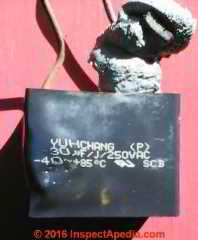
OK so we know this is probably just a single-purpose motor-start capacitor, since starting capacitors are most-often 125, 165, 250 and 330 volt devices while run capacitors are rated for higher levels like 370 and 440 volts. If it were a dual-purpose capacitor you'd see 3 rather than just 2 terminals.
You'll have no trouble buying a replacement at your local electrical supplier or even from an online supplier. Prices for a motor capacitor start at under $10. U.S.
Ask for a 30 microfarad 250VAC motor start capacitor. Take along the old sick one to show your supplier.
At MOTOR CAPACITOR WIRING GUIDE we show how to hook up a typical capacitor.
Watch out: Keep me posted on how you do, and work with POWER OFF so you live to tell me.
Question: what is the right start capacitor for the motor shown in this photo?
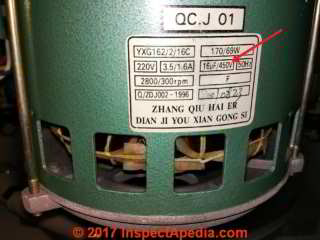 Could you please point me towards the correct capacitance for a start capacitor that can be connected to the engine presented in the attached picture?
Could you please point me towards the correct capacitance for a start capacitor that can be connected to the engine presented in the attached picture?
I'm afraid I will install a too high or too low capacitance or voltage capacitor and damage the motor. T.P. by private email 2017/07/14
Reply:
The label reads 16 µF 450V, that's the capacitor that Zhang Qiu Hai Er DianJi You Xian Gong Si the manufacturer specifies for this particular electric motor, apparently model QC.J 01.
Reader follow-up:
Correct, the labels reads 16µF 450V. Is this the capacitance/voltage that I should use for the start capacitor? The 16µF seemed too low compared to the tables you presented in your website.
Reply:
The final Authority on the correct start or run capacitor to use with any motor is of course always the motors manufacturer.
The motor shown looks like a Haier double speed electric motor shown in the photo below, excerpted from haiermotor.en.ec21.com/ where no details nor specification sheets for the motor were found.
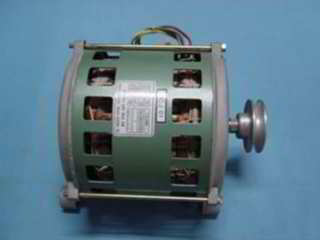
Zhangqiu Haier Electromotor Co., Ltd. is a long-established producer of Haier electric motors located in Zhangqiu Economic Development Zone Jinan, Shandong, China and doing business since 1958.
The company became a subsidiary of Haier Group in 1998. These motors are used in household appliances such as washing machines, with other motor models used in refrigerators, air conditioners and other equipment.
More information including contact suggestions for repair parts or service are found at HAIER & HAIER AMERICA
...
Â
Continue reading at MOTOR CAPACITOR WIRING GUIDE or select a topic from closely-related articles below, or see our complete INDEX to RELATED ARTICLES below.
Or see CHOOSE a START RUN CAPACITOR FAQs - Q&A posted originally on this page
Or see this
Article Series Contents
Suggested citation for this web page
CHOOSE a START / RUN CAPACITOR, HOW TO at InspectApedia.com - online encyclopedia of building & environmental inspection, testing, diagnosis, repair, & problem prevention advice.
Or use the SEARCH BOX found below to Ask a Question or Search InspectApedia











